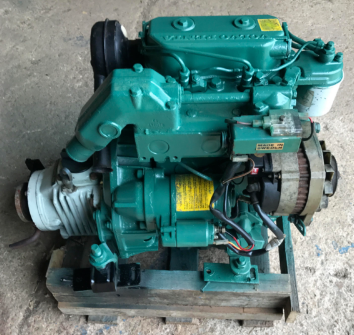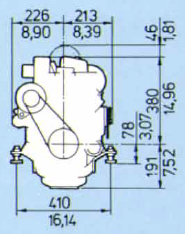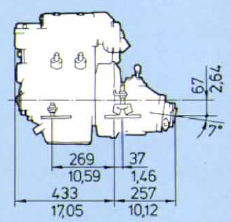
Volvo Penta 2002 Marine Diesel Engine

The Volvo Penta 2000 series of Marine Diesel engines were introduced in 1983, with the last engines produced in 1993. The Volvo Penta 2002 marine diesel was a twin cylinder naturally aspirated engine that had a cylinder displacement of 830cc and delivered 18 hp.
The 2000-Series was a complete engine program from Volvo Penta, which had been specially developed for powering sailboats and small motor boats. In addition, there was a comprehensive accessories program for the 2000-Series for other requirements, such as, heating, cooling, electricity etc. Directly injected, they were easily started and fuel-efficient marine diesels. Also, a large flywheel, decompression and cold-start facility which made cold starts easier. A 12-volt two terminal marine electrical system and AC alternator of 50A assured excellent charging and the engine was carried in vibration-damping rubber mounts providing a low noise level for the time.
Standard Equipment on the Volvo Penta 2002
1 – Engine Block
Both the cylinder head and the cylinder block of the 2002 were manufactured from cast iron for the benefits of corrosion resistance and long-life. The crankshaft used three main bearings for smooth reliable running.
2 – Fuel System
The 2002 used individual injection pumps for each cylinder. In addition, the fuel system was self bleeding. Cold starting and stop functions were operated by a joint pull control. The engine was fitted with a spin-on fuel filter for ease of service and the fuel feed pump had manual priming. Flexible fuel lines (750mm / 30in) were terminated with pipe connections.
3 – Cooling System
The 2002 had thermostatically controlled raw water cooling with easy access to the impeller pump. The cylinder head was protected from corrosion by an internal sacrificial zinc anode.
4 – Lubrication System
Pressurized lubrication system with a spin-on oil filter mounted on the front of the engine for ease of maintenance. Closed circuit crankcase ventilation.
5 – Exhaust System
An exhaust elbow with water injection which was directly connected to a rubber exhaust hose. The elbow was allowed to be turned through 90° for space saving when necessary.


6 – Reverse Gear
R (drive ratio 2.4:1) and V (3.0:1) versions were available. The R-version had the output shaft angles at 7° down relative to the engine block and the v-version was down-angled at 20°.
7 – S-Drive
A sail drive option was also available. It had a drive ratio of 2.2:1 and had a flexible diaphragm, a sealing ring and mounting. The raw-water coolant inlet was incorporated in to the drive leg. There was a shut-off valve for the coolant and sacrificial zinc anode rings mounted on the drive (labeled “13” in the image).

8 – Engine Mounts
The 2002-R variant had flexible mounting consisting of four rubber mounts with adjustable attaching plates to isolate noise and vibration. The 2002-V variant had flexible mounting consisting of five rubber mounts with adjustable attaching plates to isolate noise and vibration.
The 2002-S sail drive variant had the leg directly attached to the engine. The engine and drive were insulated from the hull by a three-point mounting system and a flexible diaphragm. A GRP engine bed added strength and a a tie-rod system prevented excessive movement in the case of running aground.
9 – Electrical System
The 2002 was designed around a 12v marine electrical system complete with instrumentation. The standard alternator had charging capacity for 14V / 50A and came supplied with a double diode unit which automatically distributed the charging current to two independent battery banks.


10 – Starting System
The starter motor had a 1.4 kW (1.9 HP) output.
11 – Instrument Panel
Came supplied with a key switch as standard. Incorporated a tachometer and control displays for high engine temperature, low oil pressure and low charge. Audible alarms for low oil pressure and for high engine temperature. There was a test button for the alarm functions. The switch operated the instrument lighting and the unit was supplied on a 3 metre (10 ft) loom for ease of positioning.
How heavy is the Volvo Penta 2002?
The different models of the Volvo Penta 2002 weighed between 139 kg (306 lbs) and 153 kg (373 lbs). The standard 2002-R weighed 139 kg (306 lbs). The 2002-V (with the additional reverse gear weighed 145 kg (320 lbs) and the 2002-S complete with sail drive leg weighed 153 kg (373 lbs).

Specifications of the Volvo Penta 2002
| Volvo Penta 2002 | |
|---|---|
| Number of Cylinders | 2 |
| Idle (no-load) speed (rpm) | 850 |
| Full load speed (rpm) | 3200 |
| Cylinder Diameter (mm) | 79 |
| Stroke (mm) | 87 |
| Displacement | 830 cc |
| Power Output (hp) | 18 hp |

Dimensions of the Volvo Penta 2002



Video: Click to watch a short video of a Volvo Penta 2002 running


A smart skipper learns from the lessons of others.
Do you own and maintain a Volvo Penta 2000 series marine diesel engine? In our Volvo Penta 2000 Series Almanac section, we have a series of previous questions and queries from VP2000 owners along with answers. Many of these have been adapted from discussions on the “Volvo Penta Marine Diesel Engine Owners Yacht and Boat Engines” Facebook group which is a fantastic resource for getting help.
Do you want to get future VP2000 Series Almanac articles straight to your inbox? Sign up to our Volvo Penta 2000 Series Owners’ Group today and we’ll make sure that you’re first to see them. And we definitely won’t share your email address with anyone else.


